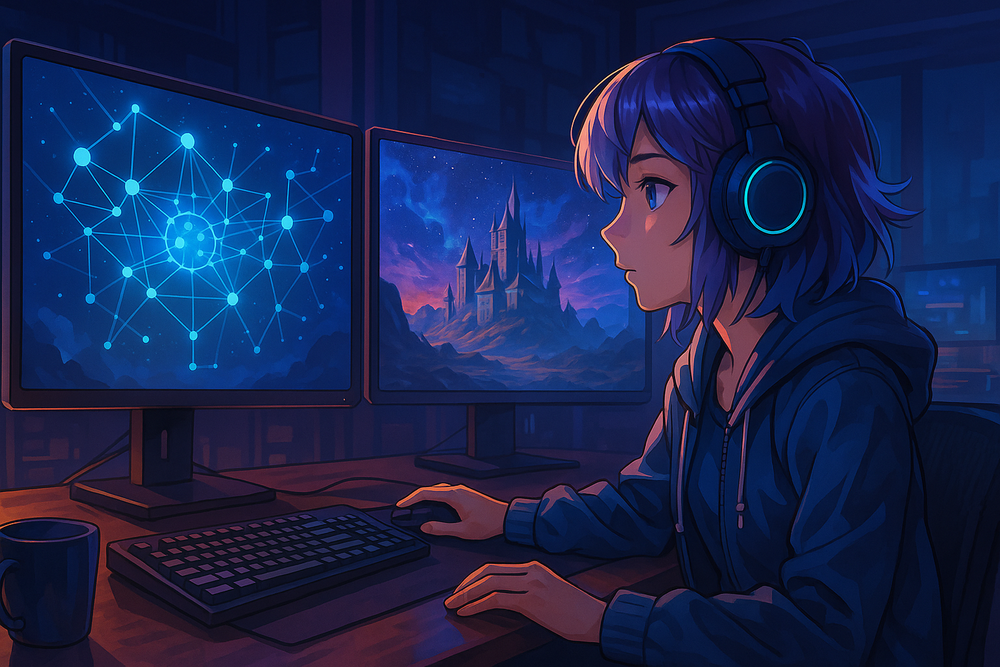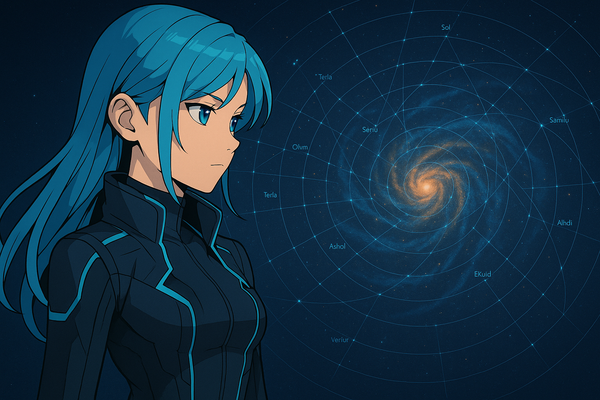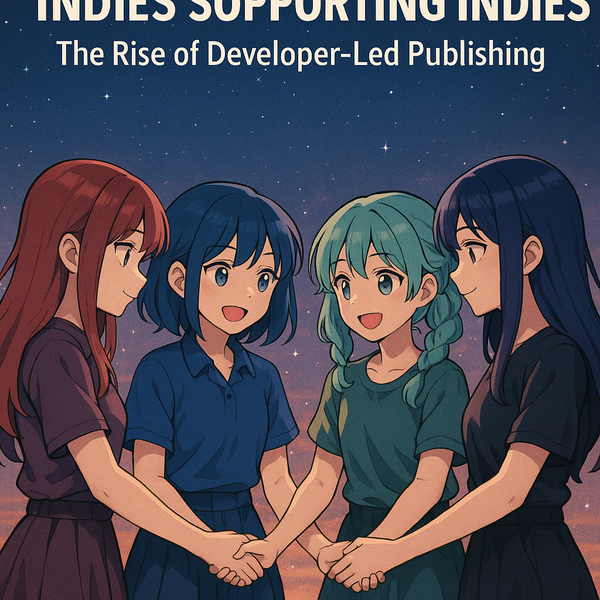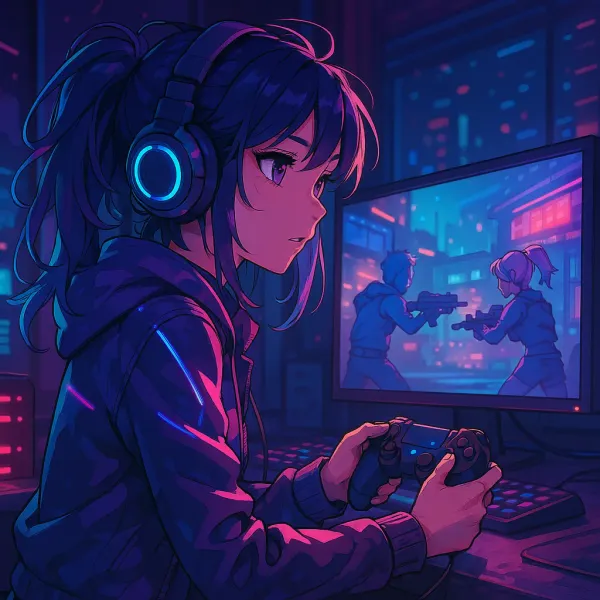Generative AI in indie games: Creative tool or ethical dilemma?
Indie developers are increasingly tapping generative AI for everything from level design to artwork, but this rise comes with both exciting opportunities and thorny questions.
Indie game creators have always worn multiple hats, juggling design, art, code, and sound often with minimal resources. It’s no surprise that many are embracing generative AI – a new breed of algorithms that can create content – as a potential lifesaver. These tools can automate the heavy lifting of content creation, promising faster development and even wholly new gameplay experiences. From algorithms that spawn infinite worlds to AI models that whip up instant art and music, generative AI is making its mark on the indie scene. Yet alongside the enthusiasm lie serious ethical and creative concerns.
In a recent industry survey, 84% of developers reported moderate to serious concerns about generative AI – citing fears of intellectual property theft, job displacement, and loss of creative control (Latest GDC Ebook Dives Into Developer Opinions on Generative AI | News | Game Developers Conference (GDC)). Some indie devs laud AI as a creative co-pilot empowering small teams, while others worry it could usher in a “death of art” if misused ('I'm worried about the death of art:' What will generative AI cost us in the end?). In this article, we’ll explore how generative AI is being used in indie games across design, art, narrative, and music – and weigh the benefits versus the controversies each step of the way.
Game Design: Procedural creativity with AI
Procedural generation is nothing new to indies – classics like Spelunky and The Binding of Isaac built rich gameplay by algorithmically generating levels on the fly (AI-Powered level design: How procedural generation is evolving in indie games). What’s changing now is the infusion of advanced AI into this process. Traditionally, a solo developer could define rules or templates and let the computer assemble endless levels, as Hello Games did to create No Man’s Sky’s 18 quintillion unique planets. This technique gave indies the power to deliver vast content with a tiny team, providing massive replayability at low cost.
Today’s generative AI can take procedural design even further. Instead of relying solely on hand-crafted rules, some indie projects are experimenting with machine learning models that learn what good levels look like and then produce new ones in that style. For example, the devs of an experimental roguelike trained a neural network on their hand-made dungeon layouts labeled by difficulty.
The AI could then generate new level designs and even adjust them to target a desired difficulty (easy, medium, hard) based on what it learned. This means an AI could “learn” a studio’s level design style and endlessly produce fresh maps that feel consistent with the game’s design ethos. Adaptive AI can also tweak content on the fly – imagine a platformer that notices you’ve mastered spike traps and accordingly dishes out more challenging configurations, or dials back the chaos if you’re struggling. In theory, this dynamic level generation keeps players perfectly in the “fun zone,” something indie devs are keen to achieve.
The upside for gameplay is clear: AI-driven design can save developers time and surprise players with unlimited variety. By handling procedural grunt work, AI lets a small team focus on the creative vision and fine-tune the experience. As one report noted, AI can manage the “mundane and time-consuming tasks” of level dressing and prototyping, freeing human designers to polish the fun parts. However, it’s not a silver bullet. Generative algorithms, if left unchecked, might churn out levels that are technically new but feel soulless or unplayable. Quality control is still paramount – a fact early roguelike creators learned when pure randomness led to unwinnable or bland levels if not carefully constrained. As one developer quipped, “Math doesn’t give two rats’ tails if your level is playable or not… it will do its job exactly as requested but not an inch more”.
In other words, an AI will happily generate content – good or bad – according to its training, so designers must guide it with sensible rules and playtesting. Generative AI in game design works best as a level design assistant rather than an autonomous architect, ensuring the final worlds still feel crafted with purpose. When used thoughtfully, it’s a powerful creative tool for indies to deliver bigger, more personalized game worlds than ever before.
AI Art and asset generation: Speed vs originality
One of the most visible (and controversial) uses of generative AI in indie games is in creating art assets. Tools like DALL·E, Midjourney, and Stable Diffusion can conjure concept art, textures, sprites, or even character portraits from simple text prompts – a tempting shortcut for a budget-strapped indie who might not have a dedicated artist on the team.
Visually, AI-generated art can now range from pixel art to near-photorealism in any style imaginable, in a fraction of the time it would take a human to draw.
This opens up new possibilities: a solo developer can instantly get dozens of creature designs or environment concepts to inspire their work. Some developers use these tools in pre-production to brainstorm ideas and prototypes. Others have gone further, integrating AI-generated images directly into their released games as backgrounds, item illustrations, or promotional artwork.
The appeal is obvious – instant art on demand accelerates production and lowers costs. However, the practice has ignited fierce debate about authenticity and ethics. Many players and creators object to AI-generated game art on principle, arguing it can dilute a game’s artistic identity and potentially misuse other artists’ work. These concerns aren’t just hypothetical. Recently, the devs of the indie hit Project Zomboid faced community backlash when eagle-eyed fans suspected that some new menu and loading screen artwork in an update looked AI-made.
The images had telltale anomalies (like a radio with a warped handle and extra microphone indentations) suggesting an AI touch (Project Zomboid developer issues statement about controversial build 42 artwork).
The developers had in fact commissioned a human artist, but even they couldn’t be sure if that artist quietly used AI in the process. Amid the uproar, the studio swiftly removed the contentious artwork “until it can be investigated fully”.
They lamented that after two years of hard work on the game update, debate over a few AI-tinged images was overshadowing their launch
This incident shows how sensitive players are to AI art – to the point that its mere suspicion can cloud an indie game’s reputation.
Beyond fan reactions, there are legal and moral gray areas. Generative models are often trained on billions of internet images, many by artists who never consented. Developers worry that using such outputs could constitute IP infringement if the AI regurgitates someone’s copyrighted material. Platform holders are taking note: Valve has stated it won’t approve games on Steam that use AI-generated assets if they infringe existing copyrights, clarifying that devs may use AI content only if they have rights to all the training data or outputs involved (Valve won’t approve Steam games that use copyright-infringing AI artwork | The Verge).
In practice, this puts the onus on indies to ensure their AI-made art isn’t unknowingly plagiarizing another artist’s style or work – a tricky proposition. Even setting legality aside, some argue that relying on AI art can undermine the very creativity that defines indie games. Game art isn’t just decoration; it conveys tone and personality. Detractors claim AI tools often produce a derivative, homogenized look, because they remix past imagery rather than truly invent. “AI art do[es] really ruin the chance of a game having a distinct art style,” one Steam user commented, reflecting a common sentiment that it’s hard to achieve a unique visual identity with off-the-shelf AI images (Liked the game, shame they use AI-generated images).
On the other hand, proponents counter that AI is just another tool – what matters is how developers wield it. For some small teams, using AI for filler artwork or minor assets can free up human artists to focus on the core visuals that define the game. Concept artists might use AI to generate variations and then paint over them, maintaining a human touch. Indeed, many in the indie community accept AI-assisted art if it’s transparent and used as a starting point rather than a final replacement for human work. But there’s a clear line emerging: completely AI-generated art in games is meeting resistance.
Indie marketplace Itch.io saw its asset stores flooded with “sketchy AI junk,” prompting calls for policy changes to protect human creators’ visibility (In defense and absolute condemnation of AI: how AI has already affected “The Game Industry” – The Candybox Blog). In the words of veteran AI programmer David “Rez” Graham, “AI is entirely derivative… It doesn’t create, it merges” ('I'm worried about the death of art:' What will generative AI cost us in the end?) – implying that true originality still comes from human imagination. The challenge for indie devs is to harness AI’s speed and versatility without sacrificing originality or ethics. Striking this balance means being mindful of where assets come from, perhaps crediting AI as just one step in a creative process, and listening to their community’s comfort level with seeing AI art in the games they love.
Narrative and dialogue: AI as a Co-Writer
Could the next great RPG writer be an AI? Storytelling is a realm where indies are cautiously experimenting with generative AI, from dynamic dialogue to whole plotlines. In fact, a few innovative games have made AI-driven narrative their central feature. AI Dungeon, an online text adventure released by indie developer Latitude, showed the world that you can have a literally infinite narrative – the game’s AI will continuously improvise story content in response to any player input, often with wild and unpredictable results (Procedural storytelling: How AI creates unique narratives in gaming.). More recently, DREAMIO: AI-Powered Adventures has brought that concept to Steam, using large language models (LLMs) to generate choose-your-own-adventure stories (complete with AI-generated illustrations) that evolve based on player decisions (DREAMIO: AI-Powered Adventures on Steam). These projects effectively turn the AI into a dungeon master or narrator, creating a personalized narrative experience for the player. For indie devs, this is tantalizing: instead of writing thousands of dialogue lines or event scripts, they can rely on an AI to fill in the gaps or even build entire quests on the fly.
The appeal goes beyond novelty. Generative AI can inject a sense of life and spontaneity into game worlds. Imagine NPCs in a sandbox game that don’t spout the same canned lines over and over, but instead chat contextually about the player’s actions or the evolving game state. Major studios are exploring this – for instance, Ubisoft’s “Ghostwriter” AI tool auto-generates drafts of NPC barks (those ambient one-liners NPCs say) to assist human writers (How Ubisoft's New Generative AI Prototype Changes the Narrative ...).
For indies, an LLM could similarly be used to generate flavorful lore books, hint notes, or dynamic dialogues that react to player choices in ways a small writing team might never have time to script. Joon Sung Park, an AI researcher at Stanford, envisions AI not replacing the big-picture storytellers but giving smaller in-game characters more to say: “he doesn’t think generative AI will take the place of human writers who come up with high-concept, compelling storylines. Instead, he sees AI making a game’s many small characters and moments more complex, more dynamic.” (Can AI create compelling video game stories? Writers have their doubts : NPR) In other words, AI might excel at the micronarratives – the incidental conversations and emergent stories – while humans still craft the central plot and themes.
However, writing is arguably where the dilemma of AI assistance vs. originality comes into sharp relief. Great game narratives often rely on coherent tone, character development, and careful plotting – areas where AI still struggles. AI text can wander off-topic or produce bizarre, immersion-breaking outputs if not carefully guided (a phenomenon known as hallucination). Consistency is another issue: an AI might make a character speak or act in a way that conflicts with earlier story events, creating narrative dissonance. These problems mean that any AI-generated dialogue usually needs a human editor or constraints to fit into a believable game narrative. There’s also the risk of biased or inappropriate content. Because AIs learn from huge datasets of human writing, they can inadvertently produce sexist or racist dialogue, or other problematic material, especially if the game’s filters are not robust. “AI systems are trained using historical data, and if the data is biased, the content generated by the AI will also be biased,” one analysis warned, noting that this can lead to offensive outputs unless developers carefully curate and constrain the AI (The Rise of Generative AI in Video Games). Indie teams dabbling in AI storytelling have to keep a close eye on such issues, often implementing moderation filters and fallback scripts to ensure the AI doesn’t go off the rails.
Then there’s the question of creative merit: Is a story that an AI wrote on the fly as satisfying as a handcrafted narrative? Some players might find the novelty thrilling – no two playthroughs are the same! – while others might feel the writing is hollow or nonsensical compared to a tightly authored tale. The Writers Guild of America even weighed in, proposing rules about AI in writing to protect human authorship in media. For narrative-driven indie games, a likely path is a hybrid approach: using AI to generate side content, minor character dialogue, or to help plot quest variants, while a human writer maintains the main story arc and ensures thematic cohesion. When done well, this can result in games with a remarkable sense of player agency and reactivity. When done poorly, it can feel like talking to a glitchy chatbot rather than a living world. As with other domains, generative AI in narrative is a tool – a very powerful one – but not a replacement for human creativity. Indie innovators will continue to tinker with AI co-writers, but they tread carefully, aware that a game’s soul still often lies in the human-crafted parts of its story.
Music and audio: Algorithms on autopilot
Music is the emotional heartbeat of a game – and here too, generative AI is making waves. A growing number of AI music tools (OpenAI’s MuseNet, AIVA, Orb Composer, Amper, to name a few) can generate original music tracks in various styles at the click of a button. For an indie developer lacking a budget for a professional composer, these tools offer a tempting proposition: custom background music without needing to compose a note yourself. Want a tense dungeon ambiance or a cheerful town theme? Describe it to the AI or feed it some reference tracks, and it can produce a passable piece in minutes. The marketing pitches are certainly enticing: “Create unique soundtracks in minutes! No musical experience required!” (The AI Invasion: How Generative Music Threatens Indie Game Sound - Wayline). Some indies use AI to prototype their soundtracks, later handing them to musicians for refinement, while others have used AI-generated tracks outright in their released games, especially for ambient or procedural music that adapts to gameplay.
The benefits here are similar to other asset generation – speed and cost-efficiency. AI can churn out music for each level or scenario, allowing even small games to avoid the dreaded repetitiveness of a single background loop. It also opens up interactive possibilities: using AI, music could adapt in real time to player actions, blending genres or changing mood on the fly, beyond the traditional layered approach to adaptive game music. Imagine a horror game where the soundtrack literally evolves differently for each player based on how the AI interprets their playstyle – this kind of experimental design is on the table with generative music systems.
Yet, when it comes to artistry, many composers and players have voiced strong reservations about AI music. Game music isn’t just filler noise; memorable indie titles often have distinctive, hand-crafted soundtracks – think of the haunting melodies of Hollow Knight, the quirky retro tunes of Undertale, or the stirring synth beats of Celeste, all of which became hallmarks of those games. There’s a fear that AI music could result in a wave of bland, samey soundtracks that lack the heart and originality of human compositions. As one indie audio expert put it, a lot of AI-generated music is merely “competent… technically proficient. But it lacks soul. It lacks the human touch, the emotional depth that comes from lived experience and artistic expression.”.
Because AI is trained on existing music, it tends to mimic familiar patterns – inherently derivative, as critics note. In one case, an indie team experimenting with an AI music generator found that the tool had basically imitated a famous game soundtrack (it produced a piece uncannily similar to Castlevania: Symphony of the Night’s theme).
They were horrified – even though it wasn’t a note-for-note copy, the vibe was so close it could have been seen as a cheap knockoff. This underscores a big pitfall: without knowing it, you might end up with music that’s too close to existing works, raising both ethical and legal red flags.
There’s also the broader impact on the creative ecosystem. Indie games have long been a space where up-and-coming composers can shine, experimenting with styles that big-budget games might shy away from. If developers start defaulting to AI for music, those opportunities for human musicians could dwindle. The “AI invasion” of game soundtracks, as some have dubbed it, threatens to “drown out these unique voices, replacing them with a sea of algorithmically generated sameness.”.
This is not to say AI music has no place – many acknowledge it can be a useful tool for placeholder tracks, inspiration, or even producing simple pieces that don’t warrant hiring a composer. But there’s a growing consensus that for a game’s key themes or emotionally pivotal moments, a human composer’s touch is irreplaceable. In response to the trend, some indie devs have doubled down on emphasizing human-made music as a selling point of authenticity.
As with art, a likely compromise is emerging: use AI to assist, not replace. An indie team might generate an AI melody and then have a musician tweak it, or use AI to quickly generate variations of a motif for different game states. This can speed up workflow while keeping a person in control of the creative direction. Ultimately, players will judge with their ears – if an AI-composed soundtrack truly resonates and elevates the experience, most won’t mind how it was made. But if it sounds hollow or generic, they’ll notice. For now, generative AI is a helpful backline player in the audio department, but the first chair violin still belongs to the human artist striving to give a game its unique sound.
Finding the balance
From the above, it’s clear generative AI offers tremendous opportunities to indie developers. It can democratize content creation, letting a tiny studio build worlds and weave experiences of a scope previously unimaginable for them. It speeds up iteration, fuels creativity by producing unexpected ideas, and can handle drudge work like testing or asset variations that often bog down small teams. In the best cases, AI acts as a collaborative partner – handling the procedural nuts and bolts while the developers focus on the creative vision. As one respondent in the 2024 State of the Game Industry report observed, “Like many new technologies, [AI tools] are not inherently good or bad. It’s how we use them that makes them useful or dangerous.” (Latest GDC Ebook Dives Into Developer Opinions on Generative AI | News | Game Developers Conference (GDC)) Used wisely, AI could level the playing field for indies, helping them compete with larger studios by augmenting their abilities. We’re already seeing this: roughly a third of game developers said they’re using generative AI in their workflows, and many more are interested.
Especially in regions like Asia, adoption is high – one survey found 70% of East Asian studios were using GenAI tools, versus about 42% in North America.
The allure of faster, cheaper creation is universal.
Yet, the challenges and risks are just as real. Ethically, generative AI sits in a gray zone regarding copyright, originality, and attribution. Indie developers worry about who owns the content an AI creates – if it was trained on others’ work, can anyone truly own the remix it spits out? There’s fear that heavy reliance on AI could lead to a glut of cookie-cutter games, flooded with derivative art and music, undermining the very originality that draws many players to indie titles. David “Rez” Graham’s stark warning at GDC 2025 resonates here: the worst-case scenario for rampant use of generative AI is “the death of art” – a future where games become a recycle of regurgitated patterns with no soul or innovation ('I'm worried about the death of art:' What will generative AI cost us in the end?). He voiced what keeps many creators up at night: “With everything just being this recycled shoveled garbage… Do we really need more lack of innovation?” .
Strong words, but they capture the anxiety that gaming could lose its human spark if AI is misapplied in pursuit of cheap content.
There’s also the human cost. While AI can take over tedious tasks, there’s concern it might also displace roles traditionally filled by artists, writers, and others. Indie studios operate on thin budgets, and the temptation to forego hiring an extra artist or QA tester because “the AI can do it” is there. The industry is already grappling with this – surveys show developers’ hesitation to embrace AI is often tied to fear of job automation and layoffs. The reputation risk is significant too: an indie title labelled as “the AI-made game” might face player backlash or boycott, as authenticity is a valued currency in the indie community. In a market where word-of-mouth and goodwill mean everything, no developer wants a stigma that their game took ethical shortcuts.
So, how can indies navigate this double-edged sword? The emerging consensus is by treating AI as a supporting tool, not a replacement for human creativity. Generative AI works best when it’s guided by a creative vision – for example, a level designer curating AI-generated layouts, or a composer editing AI motifs to ensure an emotional payoff. Studios that find the sweet spot use AI to amplify their creativity (speeding up production, providing fresh ideas) while still injecting personal artistry and making final calls on quality. As AI entrepreneur Kent Bye noted, it’s crucial to “recognize developer concerns and find ways to address them without sacrificing overall production” – meaning studios should put ethical guidelines in place, be transparent about their AI use, and ensure their human team remains at the heart of design decisions. Some are adopting a practice of having AI output undergo the same scrutiny as any outsourced work: checking for originality, tweaking to fit the game’s style, and never blindly accepting the first thing the algorithm produces.
Crucially, audience communication plays a role. Indies can turn the presence of AI into a narrative of innovation (“our game offers endless AI-driven stories!”) or, conversely, downplay it to avoid controversy, focusing marketing on the human-crafted elements. When AI Dungeon launched, it clearly sold itself on its AI novelty. In contrast, when High on Life (a larger-scale indie shooter) used some AI art and voice for minor elements, the developers clarified it was just experimental spice, not the meat of the game – trying to assuage fears that they were replacing artists entirely. Going forward, we might see indie games include credits for AI tools used, akin to crediting middleware engines, as a gesture of transparency.
In the end, creative industries thrive on human originality. Generative AI is a powerful new paintbrush, but the painting still needs an artist’s hand. The most successful indie projects using AI will likely be those that seamlessly blend algorithmic generation with human curation, yielding results neither could achieve alone. This balanced approach can turn AI into a creative collaborator that expands what a small team can do, without compromising the unique vision and heart that draw us to indie games in the first place. Generative AI in indie games is indeed both a creative tool and an ethical dilemma – but handled with care, it doesn’t have to be a zero-sum choice. As one tech writer put it, “The key lies in using it responsibly and as a complement to human skills, not a replacement” (Embracing AI in game development: An opportunity, not a threat). Indie developers who embrace that philosophy will harness AI’s advantages while preserving the artistry and integrity that make their games special.




